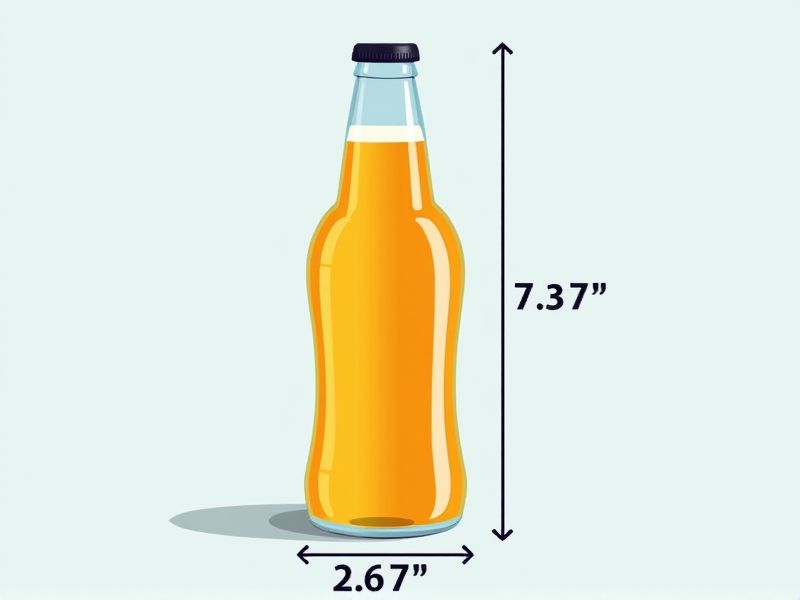
Understanding the standard dimensions of beer bottles can help you choose the right packaging or storage solutions. Most commonly, the typical 12-ounce (355 ml) beer bottle--often called a "longneck"--measures about 9 inches (approximately 23 centimeters) in height and 2.4 inches (about 6 centimeters) in diameter at its widest point. Larger 22-ounce "bomber" bottles are around 11 inches (28 centimeters) tall and slightly wider. By knowing these standard measurements, you can ensure compatibility with refrigerators, carriers, or display racks.
Volume Capacity
The standard volume capacity of a beer bottle typically ranges from 330 milliliters (11.2 ounces) to 750 milliliters (25.4 ounces). The most common size, especially for mass-produced beers, is 355 milliliters (12 ounces), which is widely recognized in North America. European beers often utilize metric measurements, with 500 milliliters (16.9 ounces) being a popular choice. Understanding these volume specifications can help you select the right beer for your occasion and ensure a satisfying experience.
Shape Design
The standard beer bottle typically features a cylindrical shape, allowing for efficient stacking and storage, with a capacity varying from 330ml to 750ml. The neck of the bottle is designed to be narrower, facilitating ease of pouring while maintaining carbonation. Glass thickness generally ranges from 3mm to 5mm, providing durability and protection against external elements. Moreover, labels often occupy a designated area of approximately 30% of the bottle's surface, ensuring brand visibility and compliance with regulatory requirements.
Neck Length
The standard neck length for beer bottles typically ranges from 18 to 30 millimeters, impacting both the aesthetics and functionality of the bottle. A well-designed neck allows for effective sealing, maintaining carbonation and freshness, with a standard cap size of 26 millimeters often used for optimal sealing. You may notice that longer necks can enhance the visual appeal, while shorter necks might enable easier handling and filling processes. Understanding these dimensions helps breweries choose the right bottle design for their brand and product offerings.
Diameter
The standard diameter of a beer bottle typically measures between 2.5 to 3 inches, depending on the design and style of the bottle. This diameter is crucial for ensuring compatibility with various bottle caps and packaging systems. For example, a 12-ounce standard beer bottle usually has a neck diameter of about 1.25 inches, which aids in efficient filling and sealing processes. Proper diameter not only influences the aesthetic appeal of the bottle but also impacts the beer's carbonation and preservation during storage.
Height
The standard height of a beer bottle typically measures between 8 to 12 inches, depending on the type of beer it contains. For mainstream lagers, bottles are often around 12 ounces, while craft beers may vary from 16 to 22 ounces in height. The design of the bottle, including its height, plays a significant role in preserving the beer's flavor and carbonation levels. Choosing a bottle that meets these heights ensures optimal storage conditions and an enjoyable drinking experience.
Label Area Space
The standard label area on a beer bottle typically measures 4 to 6 inches in height and 3 to 5 inches in width, providing ample space for essential information. This includes brand name, style, alcohol by volume (ABV), and any regulatory details, which are crucial to consumers. Customary bottle sizes like 12 oz and 22 oz often feature labels that conform to industry standards to enhance visibility on shelves. Clear, attractive design not only attracts consumers but also ensures compliance with labeling regulations, fostering brand loyalty.
Mouth Opening Size
The standard mouth opening size of a beer bottle typically measures around 26 mm in diameter. This measurement ensures a perfect balance between ease of pouring and maintaining carbonation levels. The neck design of the bottle, often tapering to this standard size, helps in minimizing oxidation and preserving flavor integrity. When selecting a bottle for brewing or bottling purposes, considering the mouth opening can significantly influence the overall tasting experience for you and your consumers.
Glass Thickness
The standard thickness of a beer bottle's glass typically ranges from 3 to 5 millimeters, offering optimal durability while maintaining a sleek appearance. Thicker glass can enhance the bottle's insulation properties, keeping your beer colder for longer periods. This robustness is pivotal in preventing breakage during transport or refrigeration, ensuring that your favorite brew arrives in perfect condition. For most brands, a balance between weight and protection is essential for both consumer experience and efficient production.
Base Width
A standard beer bottle typically has a base width ranging from 2.5 to 3 inches, ensuring stability during storage and transportation. This width is crucial, as it supports the weight of the liquid, which can be up to 12 ounces in traditional bottles. Your choice of bottle design can affect consumer perception, with wider bases often associated with premium quality. Regarding production costs, bottle widths can impact the amount of glass used, influencing overall expenses and sustainability efforts in manufacturing.
Weight Distribution
The standard design of a beer bottle emphasizes optimal weight distribution to enhance stability and usability. Typically, a 12-ounce glass bottle weighs around 8-12 ounces when empty, allowing for effective handling while preserving the integrity of the contents. The cylindrical shape often features a thicker base, which aids in minimizing the risk of tipping during transport or display. Understanding the weight distribution can significantly impact your experience, influencing both pouring efficiency and overall enjoyment.
